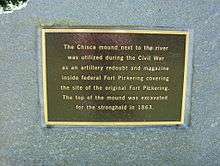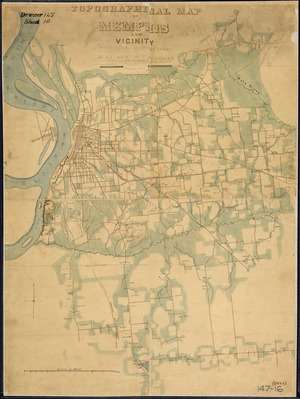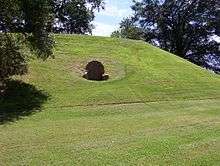Fort Pickering (Memphis, Tennessee)
Fort Pickering was built in Memphis Tennessee, by the Confederate Army during the American Civil War. It was taken over by the Union Army to provide control of the Mississippi River south of the city.[1][2]

_at_Memphis%2C_Tennessee%2C_1864%2C_drawn_by_C._Spangenberg%2C_Asst._Engr._-_NARA_-_305793.tif.jpg)

| Fort Pickering | |
|---|---|
| Memphis, Tennessee | |
 Fort Pickering  Fort Pickering | |
| Coordinates | 35.122104°N 90.074132°W |
| Site information | |
| Controlled by | Union |
| Site history | |
| Built | Circa 1810 |
| In use | 1862 to 1866 (Civil War service) |
| Garrison information | |
| Garrison | Strategic Command Post |
History

This area had earthwork mounds built by ancient indigenous peoples and used by the historic Chickasaw people, a band led by Chief Chisca. The former fort site is located within what is now the Chickasaw Heritage Park.[3]
In 1739, French colonists and militia built Fort Assumption here.[4]
During the American Civil War, the Confederate States Army built Fort Pickering on the site. The Confederates dug out the top of the mound and placed artillery there. An ammunition bunker was dug into the side of the mound.
Union forces captured Memphis in June 1862. The Union army enlarged and expanded several areas of the fort. "The newly constructed fort stretched nearly two miles along the south Memphis bluffs from where DeSoto Park (Chickasaw Heritage Park) is located, all the way to Beale Street. It was outfitted with 55 guns and included structures needed to serve the large number of troops living in Memphis and those passing through. The Indian mounds were hollowed out and artillery was placed there, along with an ammunition bunker which was dug into the side of the mound. Buildings included a hospital, rail depot, water works, and a saw mill."[5]
However, Fort Pickering's defenses were never put to the test and Union forces held Memphis throughout the war. The fort served as a major Union staging area during the Vicksburg Campaign.
Status
After Fort Pickering was demolished in 1866, all traces of the fort were removed and Memphis forgot about it - until 2007, when there was interest about the possibility of finding Civil War remnants still around. Trenches were excavated and archaeologists were able to identify two cisterns, brick foundation piers, and particularly, evidence of the defensive parapet and ditch. Further excavations found very few actual Civil War items. They had been thorough in the demolition of 1866. The items that were found were mostly evidence of an earlier residential area of a young Memphis.[3]
References
- Field, Ron (10 August 2013). American Civil War Fortifications (3). Bloomsbury Publishing. p. 21.
- Pitzman & Frick, Asst. Topl. Engineers (circa 1862). Topographical Map of Memphis and Vicinity. Surveyed & drawn by order of Maj. Genl. W. T. Sherman.
- "Fort Pickering". Historic Memphis. Archived from the original on 9 November 2013. Retrieved 15 August 2016.
- Patton, William (29 November 2011). A Guide to Historic Downtown Memphis. The History Press.
- Tower, Z B (26 March 1865). The War of the Rebellion: Formal reports, both Union and Confederate, of the first seizures of United States property in the Southern States. United States War Dept. pp. 899–901. ISBN 9780918678072. Retrieved 15 August 2016.
External links
- Archaeological Survey Weaver & Associates, 2007.